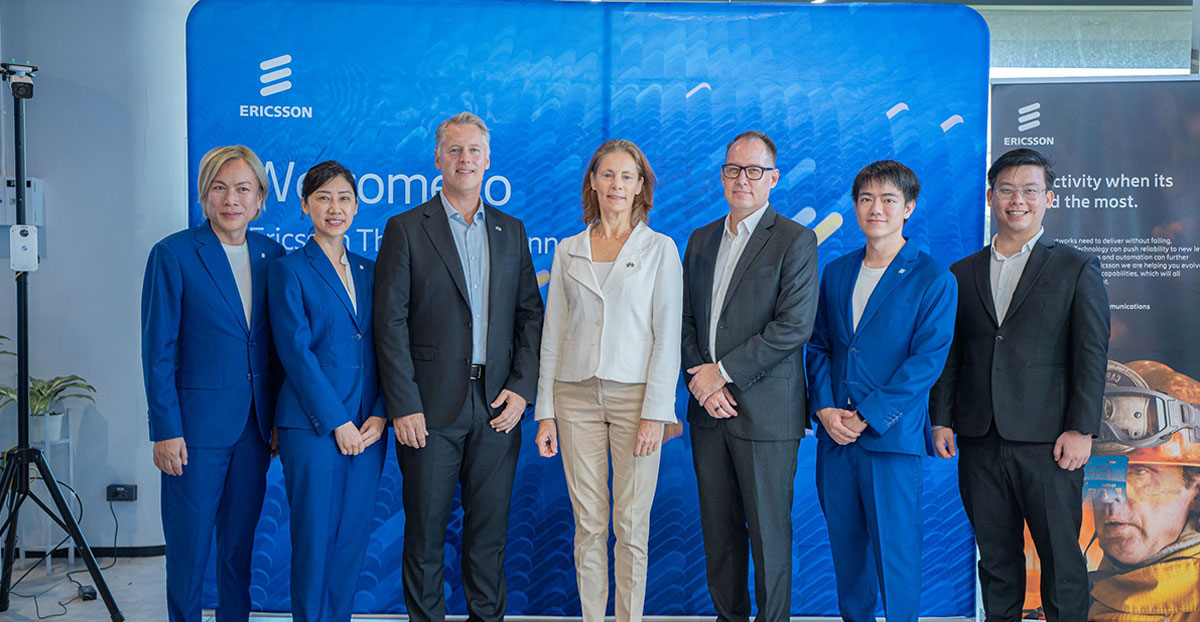เอกอัครราชทูตสวีเดนเยี่ยมชม 5G Studio ของอีริคสัน กระชับความร่วมมือระหว่างสวีเดนและไทย
นางแอนนา ฮัมมาร์เกรน (H.E. Mrs. Anna Hammargren) เอกอัครราชทูตราชอาณาจักรสวีเดนประจำประเทศไทย เดินทางเข้าเยี่ยมชม 5G Innovation & Experience Studio (5GIX Studio) ของบริษัท อีริคสัน (NASDAQ: ERIC) ประเทศไทย ที่ตั้งอยู่ในโครงการ Thailand Digital Valley จังหวัดชลบุรี โดยการเยือนครั้งนี้ถือเป็นก้าวสำคัญในการส่งเสริมความร่วมมือและกระชับความสัมพันธ์ระหว่างสวีเดนและไทยให้แน่นแฟ้นยิ่งขึ้น พร้อมตอกย้ำบทบาทของอีริคสันในการร่วมขับเคลื่อนการเปลี่ยนผ่านสู่ดิจิทัลของประเทศไทย
การมาเยือนครั้งนี้เป็นส่วนหนึ่งในภารกิจของสถานทูตสวีเดนเพื่อมุ่งเสริมสร้างและขยายความสัมพันธ์ระหว่างสองประเทศให้แน่นแฟ้นยิ่งขึ้น โดยสวีเดนและไทยมีความสัมพันธ์ทวิภาคีร่วมกันมาอย่างยาวนานถึง 156 ปี เกิดขึ้นจากพื้นฐานของการให้ความเคารพซึ่งกันและกัน รวมถึงการมีวิสัยทัศน์ร่วมกันในด้านการพัฒนาและนวัตกรรม
นางแอนนา ฮัมมาร์เกรน เอกอัครราชทูตราชอาณาจักรสวีเดนประจำประเทศไทย กล่าวว่า “นับเป็นเกียรติอย่างยิ่งสำหรับดิฉันและคณะที่ได้มาเยี่ยมชม 5GIX Studio ของอีริคสันในวันนี้ โดยสวีเดนและไทยสถาปนาความสัมพันธ์ทวิภาคีอย่างเป็นทางการร่วมกันมาตั้งแต่ปี พ.ศ. 2411 และทั้งสองประเทศต่างมีความมุ่งมั่นร่วมกันเพื่อขับเคลื่อนการเติบโตที่ยั่งยืนมาโดยตลอด สวีเดนเป็นประเทศต้นกำเนิดบริษัทเทคโนโลยีชั้นนำมากมาย เช่นอีริคสัน ที่นวัตกรรมของบริษัทสามารถสร้างประโยชน์ได้อย่างมหาศาลให้กับทั้งผู้บริโภคและภาคธุรกิจของไทย”
5GIX Studio ของอีริคสัน เปิดตัวครั้งแรกในเดือนกันยายนปีนี้ โดยทำหน้าที่เป็นศูนย์กลางความร่วมมือเพื่อการพัฒนาและคิดค้นนวัตกรรม และยังเอื้อให้เกิดความร่วมมือระหว่างผู้มีส่วนสำคัญในระบบนิเวศด้านเทคโนโลยี ได้แก่ หน่วยงานภาครัฐ ผู้ให้บริการโทรคมนาคม สถาบันการศึกษา และภาคเอกชน โดยสตูดิโอแห่งนี้สะท้อนถึงความมุ่งมั่นของอีริคสันในการสนับสนุนประเทศไทยให้ก้าวหน้าไปสู่การเป็นศูนย์กลางดิจิทัลของภูมิภาค
ระหว่างการเยี่ยมชม มร.แอนเดอร์ส เรียน ประธานบริษัท อีริคสัน ประเทศไทย ยังได้กล่าวย้ำถึงความสัมพันธ์อันยาวนานของบริษัทฯ กับประเทศไทย รวมถึงบทบาทในการร่วมกำหนดอนาคตดิจิทัลของประเทศ
“พวกเรารู้สึกเป็นเกียรติอย่างยิ่งที่ได้ต้อนรับคณะผู้แทนจากสวีเดนที่เดินทางมายังสตูดิโอของอีริคสัน ที่ทำหน้าที่เป็นแพลตฟอร์มคอยขับเคลื่อนนวัตกรรมและความร่วมมือภายในระบบนิเวศด้านเทคโนโลยีในไทย เทคโนโลยี 5G จะมอบประสบการณ์ที่น่าประทับใจยิ่งขึ้นให้กับผู้บริโภคชาวไทยและร่วมขับเคลื่อนการเปลี่ยนผ่านสู่ดิจิทัลในภาคธุรกิจให้กับประเทศ อีริคสันเป็นพันธมิตรทางเทคโนโลยีที่ได้รับความไว้วางใจของประเทศไทยมานานถึง 118 ปี และที่ผ่านมาเรายังมีส่วนร่วมพัฒนาเทคโนโลยีการสื่อสารทุกยุคทุกสมัย”
การเยือนครั้งนี้ยังแสดงให้เห็นถึงการให้ความสำคัญและยอมรับของสวีเดนต่อการมีส่วนร่วมของอีริคสันในภาคโทรคมนาคมของไทย รวมถึงศักยภาพในการเชื่อมโยงนวัตกรรมและสร้างการเติบโตทางเศรษฐกิจผ่านเทคโนโลยีขั้นสูง อาทิ 5G, ปัญญาประดิษฐ์ (AI) และระบบอัตโนมัติ (Automation)
5GIX Studio ในโครงการ Thailand Digital Valley แสดงให้เห็นถึงความเป็นไปได้จากศักยภาพของเทคโนโลยี 5G กับภาคอุตสาหกรรมต่าง ๆ เช่น การดูแลสุขภาพ การผลิต การเกษตร และเมืองอัจฉริยะ เผยให้เห็นถึงผลกระทบเชิงการเปลี่ยนแปลงของการใช้งาน 5G ต่อเศรษฐกิจและสังคมไทย





